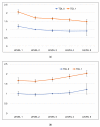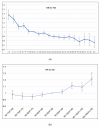Associations between Body Mass Index, Waist Circumference, and Myocardial Infarction in Older Adults Aged over 75 Years: A Population-Based Cohort Study
- PMID: 36556970
- PMCID: PMC9783624
- DOI: 10.3390/medicina58121768
Associations between Body Mass Index, Waist Circumference, and Myocardial Infarction in Older Adults Aged over 75 Years: A Population-Based Cohort Study
Abstract
Background and Objectives: Body mass index (BMI) is widely used as a standard screening method for obesity and an indicator of related diseases. However, its inability to distinguish between lean body mass and body fat limits its utility. This limitation may be more prominent in older populations, wherein age-related sarcopenia and increased visceral fat due to the redistribution of adipose tissue may preclude a precise estimation of obesity. Many studies suggest that waist circumference (WC) is more strongly related to obesity-related diseases. There are also different opinions on whether the obesity paradox is real or a result of confusing interpretations. This study seeks to determine the association between myocardial infarction (MI), BMI, and WC in older adults and to determine if BMI and WC can reliably predict the risk of cardiovascular disease. Materials and Methods: We conducted a cohort study of older Korean adults aged over 75 years registered in the National Health Insurance System Senior database. Results: The results from the analysis using model 5, which was adjusted for each study variable, showed that the lower the BMI, the higher the hazard ratio (HR) of MI and vice versa. On the other hand, groups with lower than normal WC showed lower HR; even if it was higher, the difference was not statistically significant. Those with abdominal obesity tended to have an increased HR of MI. Conclusions: This study found that HR for MI has a negative relationship with BMI, whereas it has a positive relationship with WC. Furthermore, WC is a more appropriate indicator for predicting the risk of MI in the older population.
Keywords: body mass index; coronary artery disease; myocardial infarction; older adults; waist circumference.
Conflict of interest statement
The authors declare no conflict of interest.
Figures


Similar articles
-
The Risk of Myocardial Infarction and Ischemic Stroke According to Waist Circumference in 21,749,261 Korean Adults: A Nationwide Population-Based Study.Diabetes Metab J. 2019 Apr;43(2):206-221. doi: 10.4093/dmj.2018.0039. Epub 2018 Nov 21. Diabetes Metab J. 2019. PMID: 30604597 Free PMC article.
-
Body mass index, waist circumference and cardiovascular diseases in transitional ages (40 and 66 years).J Cachexia Sarcopenia Muscle. 2023 Feb;14(1):369-381. doi: 10.1002/jcsm.13138. Epub 2022 Dec 15. J Cachexia Sarcopenia Muscle. 2023. PMID: 36522803 Free PMC article.
-
Repeated measures of body mass index and waist circumference in the assessment of mortality risk in patients with myocardial infarction.Ups J Med Sci. 2019 Jan;124(1):78-82. doi: 10.1080/03009734.2018.1494644. Epub 2018 Sep 26. Ups J Med Sci. 2019. PMID: 30256695 Free PMC article.
-
Body composition and body fat distribution in relation to later risk of acute myocardial infarction: a Danish follow-up study.Int J Obes (Lond). 2011 Nov;35(11):1433-41. doi: 10.1038/ijo.2010.278. Epub 2011 Feb 1. Int J Obes (Lond). 2011. PMID: 21285940
-
Overview of epidemiology and contribution of obesity to cardiovascular disease.Prog Cardiovasc Dis. 2014 Jan-Feb;56(4):369-81. doi: 10.1016/j.pcad.2013.10.016. Epub 2013 Oct 24. Prog Cardiovasc Dis. 2014. PMID: 24438728 Review.
Cited by
-
Association between waist-to-hip ratio and risk of myocardial infarction: a systematic evaluation and meta-analysis.Front Cardiovasc Med. 2024 Dec 9;11:1438817. doi: 10.3389/fcvm.2024.1438817. eCollection 2024. Front Cardiovasc Med. 2024. PMID: 39717446 Free PMC article.
-
Effectiveness of the active senior program in preparing for physical deterioration and quality aging among pre-older adults in Prachin Buri Province, Thailand: A quasi-experimental study.Belitung Nurs J. 2025 Apr 19;11(2):240-251. doi: 10.33546/bnj.3721. eCollection 2025. Belitung Nurs J. 2025. PMID: 40256377 Free PMC article.
-
Association between waist circumference and fatty liver disease in older adult population: a cross-sectional study in Urumqi.Front Public Health. 2025 Jul 8;13:1620261. doi: 10.3389/fpubh.2025.1620261. eCollection 2025. Front Public Health. 2025. PMID: 40697841 Free PMC article.
-
Handgrip strength is associated with mortality in community-dwelling older adults: the Yilan cohort study, Taiwan.BMC Public Health. 2023 Nov 8;23(1):2194. doi: 10.1186/s12889-023-17058-9. BMC Public Health. 2023. PMID: 37940899 Free PMC article.
-
Omega-3 Supplementation in Coronary Artery Bypass Graft Patients: Impact on ICU Stay and Hospital Stay-A Systematic Review and Meta-Analysis.Nutrients. 2024 Sep 29;16(19):3298. doi: 10.3390/nu16193298. Nutrients. 2024. PMID: 39408265 Free PMC article.
References
-
- Finucane M.M., Stevens G.A., Cowan M.J., Danaei G., Lin J.K., Paciorek C.J., Singh G.M., Gutierrez H.R., Lu Y., Bahalim A.N., et al. National, regional, and global trends in body-mass index since 1980: Systematic analysis of health examination surveys and epidemiological studies with 960 country-years and 9·1 million participants. Lancet. 2011;377:557–567. doi: 10.1016/S0140-6736(10)62037-5. - DOI - PMC - PubMed
-
- Prospective Studies Collaboration. Whitlock G., Lewington S., Sherliker P., Clarke R., Emberson J., Halsey J., Qizilbash N., Collins R., Peto R. Body-mass index and cause-specific mortality in 900,000 adults: Collaborative analyses of 57 prospective studies. Lancet. 2009;373:1083–1096. - PMC - PubMed
-
- Korea Health Statistics 2019: Korea National Health and Nutrition Examination Survey (KNHANES Ⅷ-1) [(accessed on 28 September 2022)]. Available online: https://knhanes.kdca.go.kr/knhanes/sub03/sub03_02_05.do.
MeSH terms
LinkOut - more resources
Full Text Sources
Medical

